The noise got louder and the pounding intensified. I tried to remain calm as breathing became more difficult and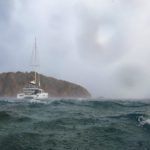 I realized I couldn’t keep my snorkel clear of water. I kicked harder, fighting to escape the deafening sound that seemed to be chasing me. I knew I had swum too close to the craggy shoreline and I was certain the next wave would hurl me into rocks. Nervously, I shifted my downward gaze and raised my head slightly to take one final look. It wasn’t crashing waves I heard. I wasn’t on the brink of slamming into the cliff. I was caught in a rainstorm.
I realized I couldn’t keep my snorkel clear of water. I kicked harder, fighting to escape the deafening sound that seemed to be chasing me. I knew I had swum too close to the craggy shoreline and I was certain the next wave would hurl me into rocks. Nervously, I shifted my downward gaze and raised my head slightly to take one final look. It wasn’t crashing waves I heard. I wasn’t on the brink of slamming into the cliff. I was caught in a rainstorm.
The sensation was startling as large raindrops pelted my head. An angry sky darkened and gray sheets of rain melded with the sea, erasing any sense of horizon and clouding my visibility. But the sea state was fine—I wasn’t in any danger and I was already wet—I might as well stay. I returned my gaze to the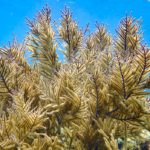 sea and as my head submerged, I noticed something interesting. It was silent below. Serene. Peaceful. Fish swam effortlessly, oblivious to the chaos above. Sea Plume swayed gently. I lifted my head and pandemonium returned instantly. Head down, tranquility. Well how about that? I think I’ll spend more time out here.
sea and as my head submerged, I noticed something interesting. It was silent below. Serene. Peaceful. Fish swam effortlessly, oblivious to the chaos above. Sea Plume swayed gently. I lifted my head and pandemonium returned instantly. Head down, tranquility. Well how about that? I think I’ll spend more time out here.
Sailing in the Caribbean has given me the good fortune of snorkeling nearly every day, sometimes several times a day. There’s no place I’d rather be. I do my best writing when I’m snorkeling. My mind quiets and I have fabulous ideas—it’s just really hard to write them down:) No matter how often I seen the same yellow and black-striped Sargent Majors or the schools of Blue Tangs, the sea is always a delight to explore. And often, I do find something new and race back to my books to learn its name and how it lives.
Did you know that Angelfish are monogamous? If one of them wanders off for a period of time, the pair will swim around each other in close circles when they reunite, strengthening their bond. It reminds me of our beloved golden retriever, Mia, who always gave me an exuberant greeting after I stepped out for only 2 minutes to get the mail. Mia always made me smile, as do the French Angelfish today.
The turtles started it. Spotting a turtle automatically raises the snorkeling grade to an A+. At the Tobago Cays in The Grenadines, there’s a turtle sanctuary where you can observe dozens of these reptiles so closely you can see their jaws move as they rip grass from the sea bottom and chew endlessly like cows of the underworld. In that very spot amidst grazing turtles, I noticed a beautiful sea star (not a starfish since it’s not a fish), perfectly displayed on the white sand below…and then there were two, three, and soon an entire field of red and yellow legs scattered like easter eggs and a few curled in balls around rocks.
As I dove down for a closer look at how a sea star clings to a rock, I discovered a lobster hiding under a ledge, wagging his long antennae forbidding me to come any closer. My peripheral vision caught movement and I turned to see a Caribbean Whiptail Stingray stirring up a meal of small fish in the sand, while bigger fish hovered, scavenging the crumbs. Sometimes, it’s only the eyes I see on these amazing creatures while the rest of their 6-foot body hides in sand waiting to ambush its prey.
The magnificent grace of a Spotted Eagle Ray always takes my breath away. Its large spotted body with a tail nearly 10 feet long glides by flapping its wings. I’m close enough to make eye contact and my heart sings. In Turks and Caicos, we had the pleasure of snorkeling in the midst of eight! of these rays, as though we were part of their synchronized swimming team. Those are the times when you forget to breathe and your heart fills with gratitude to be a witness to nature.
I finally decided to refresh my scuba skills. We were sailing the Western Caribbean and the diving was first-rate in Bonaire and the Honduran Bay Islands, with their steep walls and protected status. Many divers like the wrecks but watching Poseidon Adventure too many times has left a deep-rooted fear of something (or someone!) popping out of a dark cavernous hole. I stick to the corals and fish found only in deep water. Sixty feet below the surface on a reef wall that plunges to infinity, corals are healthy and vibrant and the fish, well, they’re bigger.
I gasped the first time an 8-foot reef shark swam by, but then calmed, remembering that I’m not really one of their food groups; they’re just curious like I am about them. The more dives I made, the more I overcame my fear of deep water. My confidence grew about equipment and monitoring my depth and ascent. I began to relax and enjoy the ultimate serenity of our planet, far below the mayhem humankind has created on the surface. I will forever treasure hearing humpback whales sing to one another as they migrated past Salt Cay.
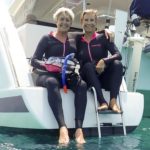 Shallow water snorkeling remains my favorite. It doesn’t cost anything, I never run out of air, there’s often more to see, and life begins right in our backyard. The first critter I often see just below the boat is a remora or sharksucker, who actually looks like a shark. It races over like the Welcome Wagon when we anchor and promptly begins cleaning the bottom of our boat. Better than coupons, don’t you think? He’s like having a pet and we like seeing him hang around into the night when our underwater lights come on. We had these lights installed when we first purchased Gémeaux so we could enjoy nighttime swims. The irony, however, is that now we can actually see the 5-feet Tarpon that are attracted to the lights and nobody wants to get in the water.
Shallow water snorkeling remains my favorite. It doesn’t cost anything, I never run out of air, there’s often more to see, and life begins right in our backyard. The first critter I often see just below the boat is a remora or sharksucker, who actually looks like a shark. It races over like the Welcome Wagon when we anchor and promptly begins cleaning the bottom of our boat. Better than coupons, don’t you think? He’s like having a pet and we like seeing him hang around into the night when our underwater lights come on. We had these lights installed when we first purchased Gémeaux so we could enjoy nighttime swims. The irony, however, is that now we can actually see the 5-feet Tarpon that are attracted to the lights and nobody wants to get in the water.  I can never resist a party of Stingrays, however, and I often put on a mask and snorkel to watch the bunch of them busily stir up dinner just below me. I don’t stray far from the stern of the boat, however, and I’ve never tried night diving because, well…I’m still afraid of the dark.
I can never resist a party of Stingrays, however, and I often put on a mask and snorkel to watch the bunch of them busily stir up dinner just below me. I don’t stray far from the stern of the boat, however, and I’ve never tried night diving because, well…I’m still afraid of the dark.
In full daylight, patient and still as a floating log, I uncover entire miniature civilizations. I can see eyelashes on Redlip Blennies and the brilliant architecture of a juvenile Queenfish. Social Feather Dusters and Christmas Tree Worms pop in and out of Brain Coral. I’m close enough to touch them, though I never do. Instead, I watch them open up their fan-like arms once they’ve established I’m not an enemy. Occasionally, my vision is obscured by too many fish. Blizzards of tiny Silversides form fish balls according to size and disperse only to clear a path for me or when a pelican dives in for a meal.
Determined to find more critters in this little paradise, I notice a Chain Moray eel poke only its head out, opening and closing its jaws like it might bite, but in fact is only bringing water down to its gills. Conventions of small Bluestriped Grunts cluster together until they’re big enough to join their older friends in the deeper reefs.
A speck of sand moves and I discover a Peacock Flounder or a Lizardfish, showing off their camouflaging skills. Not everyone protects themselves with camouflage. The small shell-like Flamingo Tongue, usually attached to the purple Common Sea Fan, has bright orange spots outlined in black to warn predators that they are toxic.
At Sandy Isle in The Grenadines, I stumbled upon a pair of Flying Gunards, the larger male, exquisitely decorated with blue tips on its back fins. It was fascinating watching them eat—crawling on the bottom, using their front fins like hands to flip over rocks, quickly seizing the startled mollusk or snail as its home is turned upside down. Yellowhead Jawfish with light blue flowy tails are only 4-5 inches long so they’re hard to spot, but so interesting to watch catch a meal. They hover vertically above their sand dwellings snatching bits of floating plankton and then plunging tail first back in their hole at the first threat of danger.
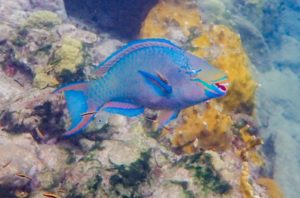 The iconic Parrotfish in all their variations deserves the community service award for maintaining health reef ecosystems by scraping away meals of algae. Then, they create our beaches by expelling what becomes fine sand…did you know that’s what you’re sitting on?! If you listen closely, you can actually hear the crunch crunch sound of these fish biting into the coral with their front teeth. Harems of these colorful fish (yes, most are female) are dominated by a single dominant male (boo). If the male dies, the strongest female can become a male (wow!) and takes over the harem. Now there’s food for thought.
The iconic Parrotfish in all their variations deserves the community service award for maintaining health reef ecosystems by scraping away meals of algae. Then, they create our beaches by expelling what becomes fine sand…did you know that’s what you’re sitting on?! If you listen closely, you can actually hear the crunch crunch sound of these fish biting into the coral with their front teeth. Harems of these colorful fish (yes, most are female) are dominated by a single dominant male (boo). If the male dies, the strongest female can become a male (wow!) and takes over the harem. Now there’s food for thought.
Every creature has a personality. The red Squirrel Fish with its giant, black eyes, is shy. I keep my distance, knowing my presence makes them nervous.
Scrawled Filefish almost always travel in pairs so if I see one, I search for the other and find it eating Fire Coral, toxic to the human touch. I discover that many fish remain in the same area. If I return the next day, I find the same Porcupinefish hiding under the ledge where I saw it yesterday. And yes, there’s nap time in the underworld. Schools of fish sitting, er…standing, er…swimming what’s the word?…in place. One fish was completely vertical with its mouth agape as if it was snoring and lost in some faraway dream.
And then there’s the Octopus, who has the largest brain of all invertebrates; has the uncanny ability to change color, size, shape, and texture; and, with three hearts, simply must have the biggest personality. Octopuses (you can’t put a Latin ending on a Greek word so never octopi) are hard to find until you find one. I searched endlessly for this fascinating creature, until one day I noticed a pile of freshly-cleaned empty shells standing out against a landscape of brown rocks. I knew instantly a well-fed octopus lived just behind its decorated front door. Now, I see octopuses nearly every time I snorkel—I just look for the collection of polished shells and quietly peek in every nook and cranny until I find two big sleepy eyes or a huge beak sucking in yet another meal.
Sometimes, when a small fish swims by, an arm flails out of the hole as if swatting away an annoying fly. By far, the most memorable experience was in Sand Hole near Grand Turk, where a Caribbean Reef Octopus, dressed in green that day, allowed us to watch it eat an enormous Conch lunch. If you’re still ordering Octopus in a restaurant, I invite you to read Sy Montgomery’s The Soul of an Octopus, an illuminating and compassionate tale of these enchanting creatures that will give you pause next time you find it on the menu.
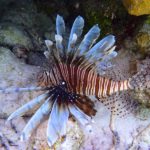 There are things we find that we don’t want to find in the sea. Jellyfish. Not really, the turtles would be unhappy if their food source disappeared. The Lionfish, stunning as it is, are an invasive species, not native to the Caribbean. They have no natural predators and satisfy their voracious appetites by eating their way through entire ecosystems.
There are things we find that we don’t want to find in the sea. Jellyfish. Not really, the turtles would be unhappy if their food source disappeared. The Lionfish, stunning as it is, are an invasive species, not native to the Caribbean. They have no natural predators and satisfy their voracious appetites by eating their way through entire ecosystems.
No matter how faraway the place, we always seem to find trash. The winds and the currents bring in pounds of junk each day from distant places like Africa. Environmental education hasn’t reached some of these destinations. Even in the pristine water of the San Blas Islands of Panama, trash collects at the shoreline because a better disposal system is simply out-of-reach.
Just this week in The Bahamas’ remote Jumento Cays, I kept finding small plastic bags while snorkeling, some of them seemingly unopened but now filled with sand and shells. What could these be? I then learned that they are emergency water, provided in disaster-relief situations. Sadly, they end up in the sea creating a new disaster. There must be a better way.
 Nature calls…time to discover some more amazing critters. Join me in spreading the word about the magical life underwater. I know you’ll do your part in picking up any evil plastic you find on your own snorkeling adventures.
Nature calls…time to discover some more amazing critters. Join me in spreading the word about the magical life underwater. I know you’ll do your part in picking up any evil plastic you find on your own snorkeling adventures.
Enjoyed this post?
Sign up at the bottom of this page
to receive email notifications of future posts!

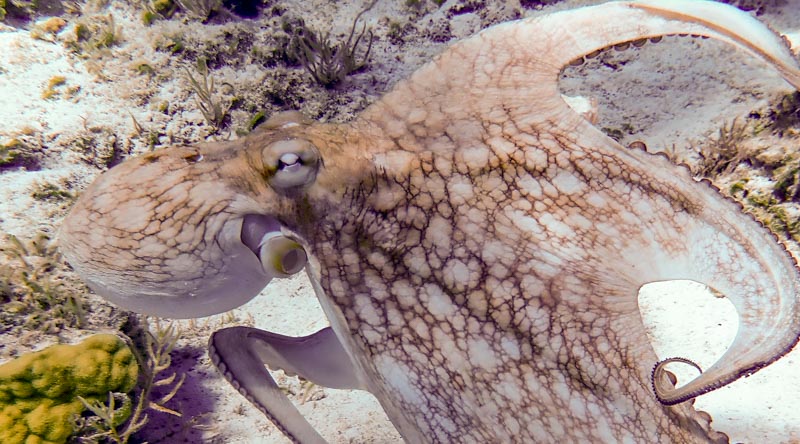
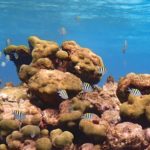
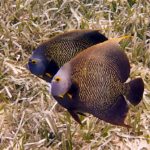


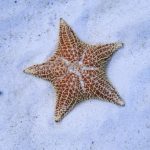
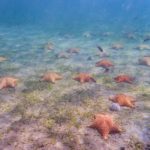

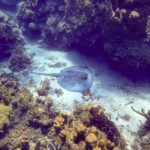
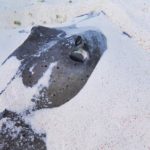
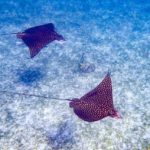
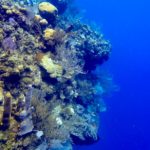
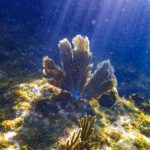
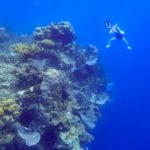

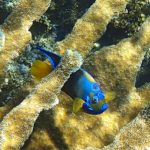
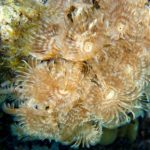
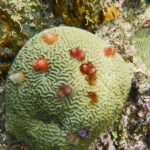

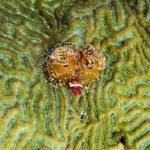
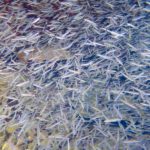
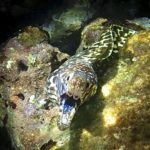
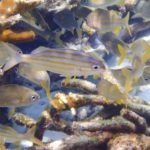
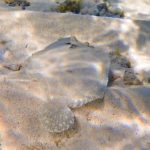
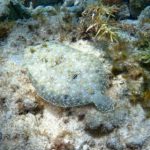
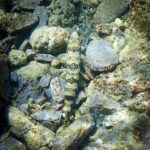
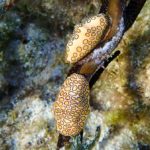
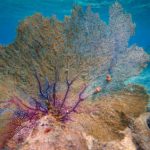
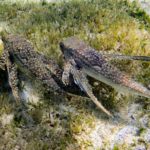
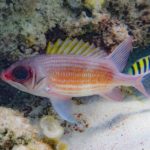
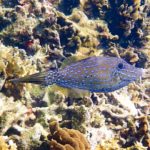
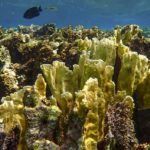
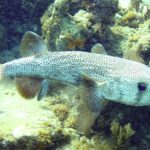
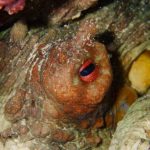

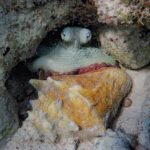
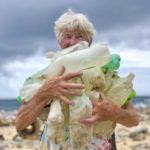



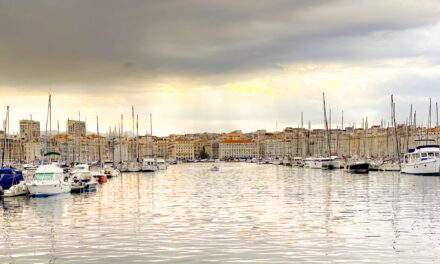

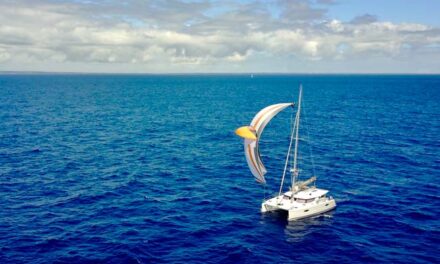


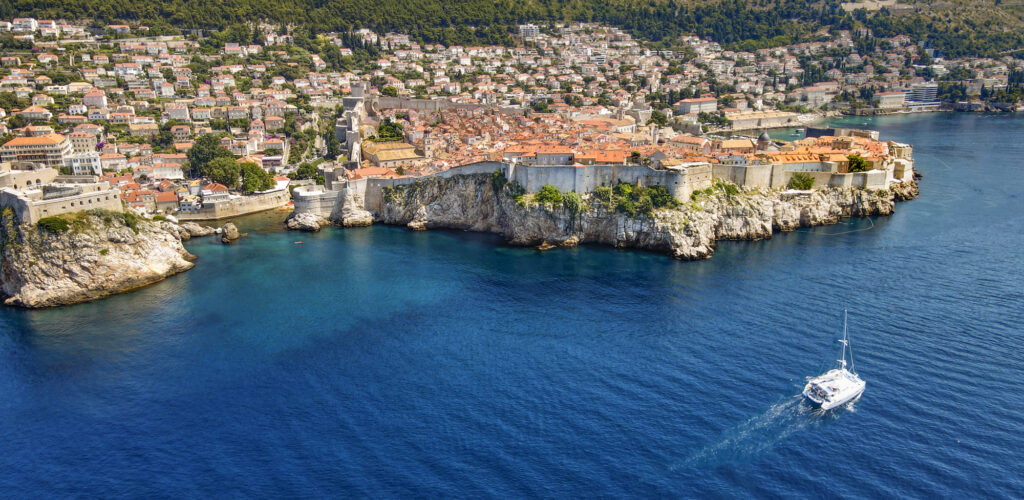
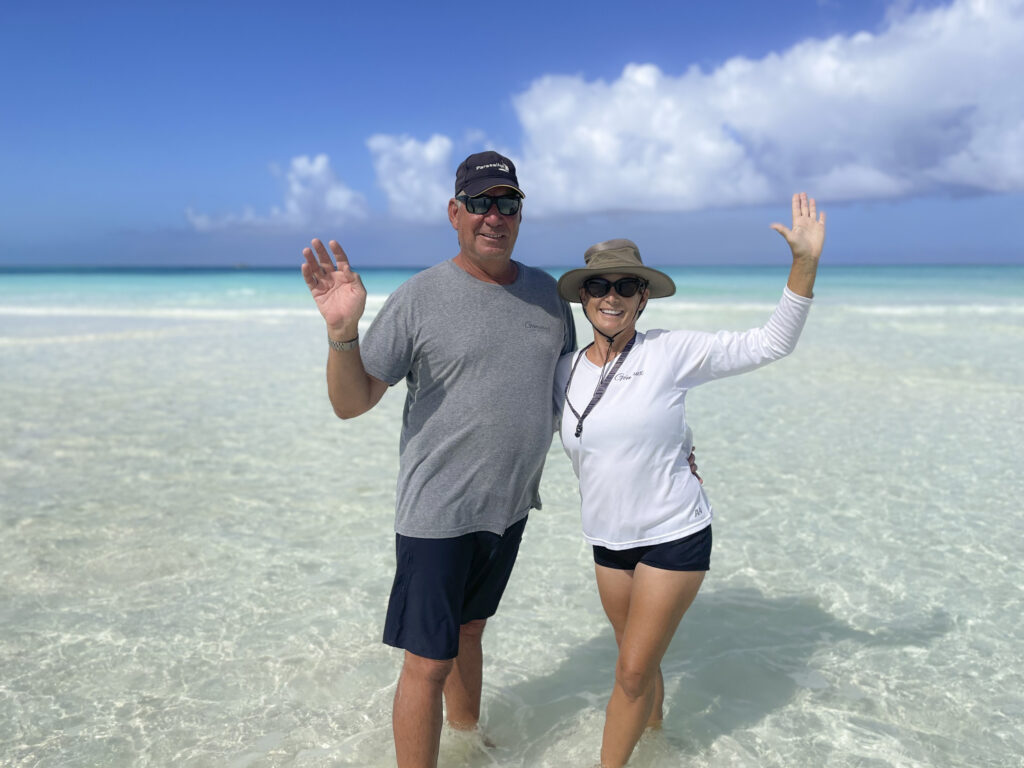
Wow, what an amazing under water life you have. Finally, I got a blog notice that didn’t go to my spam folder, too. Would a tarpon ever bite a human?
You’re not really on his diet unless you’re mean to him.